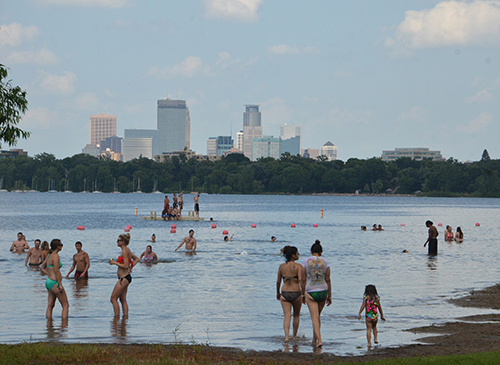Regional parks in the metro area got nearly 60 million visits in 2018, an increase of 2.6% over the previous year and the most visits of any year on record. The findings are from the Metropolitan Council’s annual estimates of visits to the regional parks system (PDF).
More than one-third of visits, 20.8 million, were to regional parks in Minneapolis, including the ever-popular Minneapolis Chain of Lakes.
 Regional parks in Anoka County had the largest gain in visits, topping 2017 visits by more than 520,000. Dakota County had the highest percentage increase in the number of visits, with a 14% increase over 2017.
Regional parks in Anoka County had the largest gain in visits, topping 2017 visits by more than 520,000. Dakota County had the highest percentage increase in the number of visits, with a 14% increase over 2017.
“We love our parks,” said Chair Nora Slawik. “Our regional park system is known nationally for its size, beauty and many features. We’re fortunate to have this wealth of resources, which adds immeasurably to the region’s livability and quality of life, lending access to exercise, recreation and respite.”
Developing/maintaining regional parks takes partnerships
The Metropolitan Council is charged with overseeing the acquisition and development of regional parks and trails. Operations are in the hands of 10 partner cities, counties and special districts.
As of the end of 2018, the regional system included 44 regional parks, 12 park reserves, 49 regional trails and eight special recreation features, including the Como Park Zoo and Conservatory and Noerenberg Gardens on Lake Minnetonka.
Two new trail segments were added to the parks system in 2018; Point Douglas Regional Trail in Washington County and Nokomis-Minnesota River Regional Trail in Bloomington.
Park funds come from a variety of sources, including the State of Minnesota's Clean Water, Land & Legacy Amendment, and the Environment and Natural Resources Trust Fund.
Council parks policies support preservation, growth, access and equity
.jpg.aspx?width=328&height=250) Council officials say parks promote vibrant communities and healthy people. Regional policies are committed to:
Council officials say parks promote vibrant communities and healthy people. Regional policies are committed to:
-
Expanding the Regional Parks System to conserve, maintain, and connect natural resources identified as being of high quality or having regional importance.
-
Providing a comprehensive regional park and trail system that preserves high-quality natural resources, increases climate resiliency, fosters healthy outcomes, connects communities, and enhances quality of life in the region.
-
Promoting expanded, multimodal access to regional parks, regional trails, and the transit network, where appropriate.
-
Strengthening equitable use of regional parks and trails by all our region’s residents, such as across age, race, ethnicity, income, national origin and ability.
Methodology
To estimate regional parks visitation, data were collected within each park and trail during the summer (Memorial Day to Labor Day) and then expanded to produce an annual estimate. The Council has developed an online tool, available at metrocouncil.org/parkestimates, that describes how annual estimates are developed and provides usage statistics for each park and trail in the regional parks system.
More about 2018 regional park system visits (PDF)